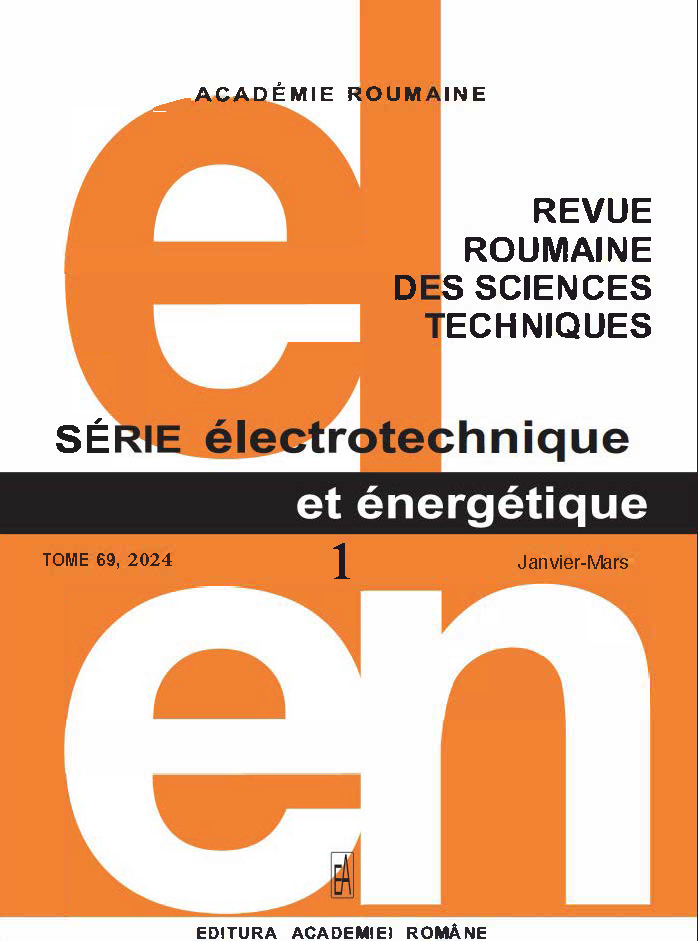SECOND ORDER SLIDING MODE CONTROL FOR ISLANDED AC MICROGRIDS WITH RENEWABLE POWER RESOURCES
COMMANDE À MODE GLISSANT DE DEUXIÈME ORDRE POUR LES MICRO-RÉSEAUX CA ILOTÉS AVEC RESSOURCES ÉNERGÉTIQUES RENOUVELABLES
DOI :
https://doi.org/10.59277/RRST-EE.2024.1.7Mots-clés :
Micro-réseau (MG), Stratégie maître-esclave, Contrôle de puissance, Contrôle du mode coulissant de deuxième ordre, Contrôle de tensionRésumé
Les micro-réseaux ont suscité beaucoup d’attention et constituent l’avenir des systèmes électriques. Cet article propose un nouveau schéma de contrôle pour les micro-réseaux ca (MG) insulaires utilisant la technique maître-esclave. La stabilité et les hautes performances sont vitales pour les MG insulaires. Deux commandes à mode coulissant (SMC) de second ordre sont conçues dans des cadres de référence stationnaires pour les unités maître et esclave afin de contrôler la tension et la puissance. Les deux contrôles conçus garantissent la convergence des sorties considérées vers leurs valeurs de référence. Les contrôles proposés sont robustes, simples et sans broutage, et ne nécessitent que des mesures locales. La méthode de contrôle proposée dans cet article peut être facilement étendue aux micro-réseaux avec n'importe quel nombre d'unités esclaves et d'onduleurs connectés en parallèle. L'efficacité du schéma de contrôle proposé est vérifiée grâce aux résultats de simulation dans l'environnement MATLAB/Simulink et comparée au contrôle de linéarisation par rétroaction et à un SMC conventionnel modifié.
Références
(1) M.M. Rezaei, J. Soltani, A robust control strategy for a grid-connected multi-bus microgrid under unbalanced load conditions, International Journal of Electrical Powers, and Energy Systems, 71, pp. 68–76 (2015).
(2) T. Caldognetto, P. Tenti, Microgrids operation based on master-slave cooperative control, IEEE Journal of Emerging and Selected Topics in Power Electronics, 2, 4, pp. 1081–1088 (2014).
(3) P. Monshizadeh, C. De Persis, N. Monshizadeh. A. van der Schaft, A communication-free master-slave microgrid with power sharing, 2016 American Control Conference (ACC), Boston, USA (2016).
(4) P. Kumar, M. Kumar, N. Pal, An efficient control approach of voltage and frequency regulation in an autonomous microgrid, Revue roumaine des sciences techniques, 66, 1, pp. 33–39 (2021).
(5) Y. Daili, A. Harrag, Improved decoupling virtual synchronous generator control strategy, Revue roumaine des sciences techniques, 66, 3, pp. 153–160 (2021).
(6) A. Alfergani, A. Khalil, Modeling and control of master-slave microgrid with communication delay, The 8th International Renewable Energy Congress (IREC 2017) (2017).
(7) H. Han, X. Hou, J. Yang, J. Wu, M. Su, J.M. Guerrero, Review of power-sharing control strategies for islanding operation of ac microgrids, IEEE Trans. On Smart Grid, 7, 1, pp. 1–16 (2015).
(8) J. Pinto, A. Carvalho, V. Morais, Power sharing in island microgrids, Frontiers in Energy Research, 8, Article 609218, pp. 1–14 (2021).
(9) A. Ghazanfari, M. Hamzeh, H. Mokhtari, H. Karimi, Active power management of multihybrid fuel cell/supercapacitor power conversion system in a medium voltage microgrid, IEEE Trans. On Smart Grid, 3, 4, pp. 1903–1910 (2012).
(10) M. Hamzeh, H. Karimi, H. Mokhtari, A new control strategy for a multi-bus mv microgrid under unbalanced conditions, IEEE Trans. On Power Systems, 27, 4, pp. 2225–2232 (2012).
(11) P.J. dos Santos Neto, T.A.S. Barros, J.P.C. Silveira, E.R. Filho, J.C. Vasquez, J.M. Guerrero, Power management techniques for grid-connected dc microgrids: a comparative evaluation, Applied Energy, 269, 115057, pp. 1–15 (2020).
(12) M.S. Mahmoud, O. Al-Buraiki, Two-level control for improving the performance of microgrid in islanded mode, 2014 IEEE 23rd International Symposium on Industrial Electronics (ISIE), Istanbul, Turkey, pp. 54–59 (2014).
(13) T. Yao, R. Ayyanar, Variable structure robust voltage regulator design for microgrid master-slave control, 2017 IEEE Energy Conversion Congress and Exposition (ECCE), Cincinnati, OH, USA (2017).
(14) H. Liang, Y. Dong, Y. Huang, C. Zheng, P. Li, Modeling of multiple master–slave control under island microgrid and stability analysis based on control parameter configuration, Energies, 11, 2223, pp. 1–18 (2018).
(15) J. Marchgraber, W. Gawlik, Investigation of black-starting and islanding capabilities of a battery energy storage system supplying a microgrid consisting of wind turbines, impedance- and motor-loads, Energies, 13, 5170, pp. 1–24 (2020).
(16) M.M. Rezaei, J. Soltani, Robust control of an islanded multi-bus microgrid based on input–output feedback linearization and sliding mode control, IET Generation, Transmission & Distribution, 9, 15, pp. 2447–2454 (2015).
(17) W. Perruquetti, J.P. Barbot, Sliding mode control in engineering, Marcel Dekker, Inc., NY (2002).
(18) A. Mehta, B. Naik, Sliding mode controllers for power electronic converters, Springer Nature, Singapore Pte Ltd. (2019).
(19) M. Cucuzzella, G.P. Incremona, A. Ferrara, Design of robust higher order sliding mode control for microgrids, IEEE Journal on Emerging and Selected Topics in Circuits and Systems, 5, 3, pp. 393–401 (2015).
(20) R. Seeber, M. Reichhartinger, Conditioned super-twisting algorithm for systems with saturated control action, Automatica, 116, pp. 1–9 (2020).
(21) H. Obeid, S. Laghrouche, L. Fridman, A barrier function based-adaptive super-twisting controller for wind energy conversion system, 2019 IEEE 58th Conference on Decision and Control (CDC), Palais des Congrès et des Expositions Nice Acropolis, Nice, France, December 11–13, pp. 7869–7874 (2019).
(22) R. Teodorescu, M. Liserre, P. Rodriguez, Grid converters for photovoltaic and wind power systems, John Wiley & Sons, Ltd, United Kingdom (2011).
Téléchargements
Publiée
Numéro
Rubrique
Licence
(c) Copyright REVUE ROUMAINE DES SCIENCES TECHNIQUES — SÉRIE ÉLECTROTECHNIQUE ET ÉNERGÉTIQUE 2024

Ce travail est disponible sous licence Creative Commons Attribution - Pas d'Utilisation Commerciale - Pas de Modification 4.0 International.


